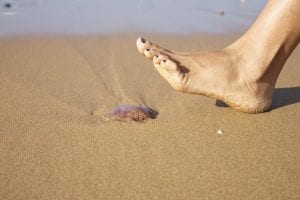Jellyfish appear as a smooth, translucent bell in the ocean waters and are often seen on the beach shoreline. They are fun to watch and may appear harmless at first. However, when our skin comes in contact with the jellyfish’s tentacles – the pain is instant! Angry, red, whip-like lash marks radiate from the sting site and it starts to itch, burn and throb. Thankfully, the discomfort will peak after about five minutes and dissipate over the next few hours.
So what do you do if you or a family member has an encounter with one of these translucent, bulbous creatures? Don’t pee on it! Experts suggest that urine may even worsen the sting.
The recommended treatment is to immediately get out of the water and remove any tentacles. Use something such as a credit card to brush them off or lightly rub sand over the site. Do not scratch the stung area because the remaining stinging cells will fire and release even more venom. After you remove the tentacles, treat the pain by immersing it in hot water for at least twenty minutes.
Jellyfish stings can spoil an afternoon at the beach, so always keep your eyes open. If you see dead jellyfish on the shoreline beware they will be present in the water also. Although most jellyfish found along our beaches are not dangerous to people, if you are traveling to other countries be cautious as some species of jellyfish are extremely toxic. If the person shows signs of a severe allergic reaction, always seek immediate medical attention.
The jellyfish sting is so painful you will be anxious to find relief but urine is not your answer. It is a medical myth!




